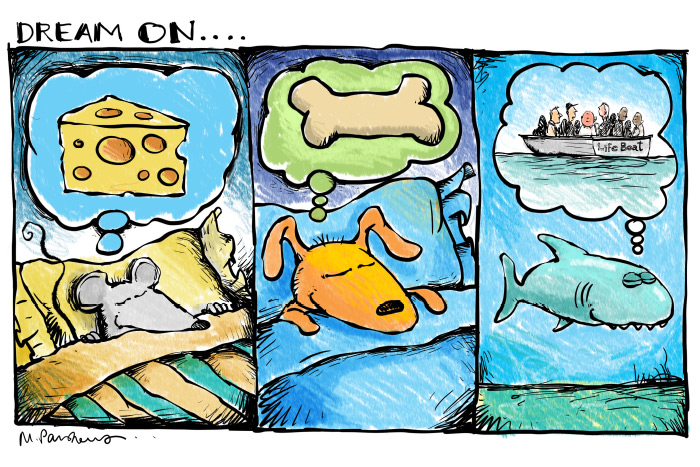Zzzzzzzz: You Sleep, I Sleep, the Giraffe Sleeps and the Platypus Sleeps

For years, scientists have tried to learn about why we sleep. For starters we know that certain kinds of thinking light up particular parts of the brain. So we can agree that deep thought and figuring out puzzles resides over here and anger and the more primitive emotions light up stuff over there.
The light and dark in many ways reminds people of thunderstorms and lightning. It’s also seen that there is less of this activity when people begin falling asleep and even less when they drift into the deep sleep called REM sleep (Rapid Eye Movement sleep).
Further study has caused us to consider the parts lighting up as synapses. These are electric currents that link up neurons and allow our brains to learn lessons in life. At night, some of these synapses reduce in size or go away, but others remain. During the next day, new synapses are added.
The New York Times recently reported on two studies, one in the journal Science and the other at John Hopkins University, that have gone where no man has ever gone before.
The first study was published by two biologists at the University of Wisconsin-Madison, Giulio Tononi and Chiara Cirelli. In earlier work, they had seen how the brain circuits seem to get “noisy” during the day and “quieter” during the night. In a follow-up, they found evidence for it. Studying the brains of mice, they learned the synapses were 18% more active in the day than at night when the mice were asleep.
The second study, by Graham H. Diering at Johns Hopkins, took it even further. He and his colleagues looked into the brains of mice and analyzed the chemicals that seemed to cause the brains to cut down on synaptic activity and “clean themselves up” at night. They found one protein that might be especially important, called Homer1A.
Diering and his team then performed a test. Mice were introduced to a room and allowed to run around in it. Under the center of the floor was a circuit that applied a small electric shock there. When the mice stepped on it, they jumped with surprise. That night, some of the mice got an injection that stopped their synapses from cleaning themselves up when they slept.
The next day, all the mice, those who got the injections and those who didn’t, were put in a new room. It did not have any electric charge under the center. The mice were free to run around. However an odd thing happened. The mice who got the brain injection retained the fear of stepping into the center of the box. They kept clear of the center of that room, sniffing and running around along the perimeter, where it was safe. Those that could make use of their normal HomerA1 had completely forgotten what had happened with the other room the previous day and ran around happily in the center, on the sides and everywhere else without worries.
Dr. Diering has concluded that in that first day, all the mice created synapses that told the brain “be afraid of going in the center of the box.” During the night, the normal
mice purged that fear using the Homer1A protein. But the injected mice had not had those “watch out” synapses from the day before removed. My guess is that in other matters that second day, they were also very high-strung and annoyed, expecting trouble at any time. The regular mice probably thought, what was wrong with these other mice?
The moral of this story is, I think, that it is a good idea to get plenty of sleep to let your interior thunderstorms die down and slough off the proteins that will free you up from some of the nicks and cuts that happened the day before that aren’t that important.
I also think that this explains why people who sleep only three hours a night can sometimes get so irritable and irrational. They haven’t given old Homer in there the time to sort things out and get on with the good and get rid of the bad.
And as for what you choose to remember and forget, if you’ve been trying to follow the 10 Commandments, your brain, with this good moral compass, will get it all sorted out.
Unanswered here, however, is the question of just how much stuff can we learn with our brains. If Homer sloughs off some synapses during the night but not all, there must be an ever-increasing amount of stuff kept in. Call that Wisdom. But is it a finite number?
Some argue that, like any good hard drive, the amount we can retain is absolutely enormous—mind-boggling, if you will. But others point out that older people often seem to have reached the limit—and their brains get to keep, for example, the day they won first prize in the Environmental Essay Competition in third grade, but they can’t remember the name or face of the person sitting next to them at the dinner party who they are told they met last week.
As far as creatures on this planet are concerned, it does seem to us humans that practically everybody—the birds, snakes, raccoons, bears, countries at war and regular neighbors—all are awake during the day hunting, eating, striving, having sex, playing and working, but sleep at night. To a great degree that is the case, though because we all are asleep and make that assumption, there are little noticed exceptions: nocturnal animals and animals who simply nap on and off all day and all night.
But we’re up at the top, or near it. Scientists have learned that the percentage of REM sleep that humans get every night is far greater than almost any other creature, except the platypus.
“The platypus is the champion [of REM sleepers]” said Dr. Jerome M. Siegel of the University of California at Los Angeles.
It’s also true that we have bigger brains than all other creatures, even including the platypus. But there is a very wide variety of the amount of both total sleep and REM sleep amongst the mammals.
Horses sleep only two hours a day. (Ever see a horse asleep?) Giraffes need only 1.9 hours a day. Elephants three. At the other end, we have brown bats that sleep 20 hours a day, owl monkeys 18, tigers 17 and pythons 18. The platypus sleeps 14.
Back in my college days, I recall an anthropologist telling us about the two scientists who went out into the African savanna to watch the monkeys while they played. They got there very early in the morning so as to see them sleeping in the trees and then wake up to get going. They waited in the bushes half an hour, then an hour, two hours, four hours, six hours, then went home, and the monkeys were still asleep in the trees.
Humans average eight hours and were among the first creatures of our size to stop sleeping in trees. About 2 million years ago, clear fossil evidence suggests that our ancestors Homo Erectus began sleeping on the ground—and got more REM sleep if they did so in large groups.
On the other hand, to this day gorillas create large sleeping nests by carefully gathering up branches and leaves to put on several strong boughs up in trees for a good night’s sleep. It’s not easy.
Sleeping on boughs with interruptions from wind, birds, tree snakes and other primates does not allow for steady REM sleep. It is “like economy class on a plane,” researcher David R. Sampson noted.
Sleep tight.



